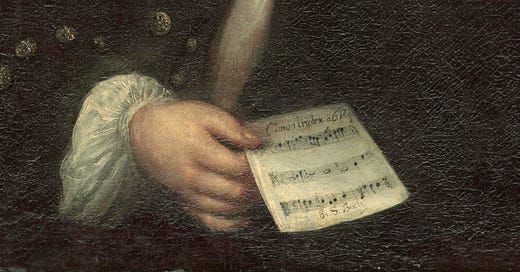I recently saw an analysis of a passage by Bach that was so convoluted it made me think I was having a stroke. I wonder if people make too much of musical analysis generally. It’s one thing if you’re a theorist doing a rigorous study, but for the purposes of performance, it’s possible to understand most pieces—intellectually, not spiritually, which is a different matter entirely—if you spend a few good hours with the score, pencil in hand, asking simple questions and answering them honestly. Here are the kinds of things I think about:
What is the tune, the thing that one sings when one recalls this piece? Is it melodic or rhythmic, or a little of both? Does it arrive fully formed, or is it developed slowly? Is it repeated often? If so, is it always the same or quite different? Is it a major or a minor theme, and how does the composer use it—if indeed he does at all—in the opposite mode? What is its affect? What are its contours? In the case of Bach especially, does the theme come from elsewhere? How might he have heard it, and why might he have chosen it?
Identify any secondary themes, countermelodies, little motives, etc. and ask similar questions. How does all this material interact? Is it a battle for supremacy, a spirited ballet, or simply melody and accompaniment? Is there a clear hierarchy of voices, or is the material shared equally among them? What is the texture of the piece generally, and where does it change? If it is dense, where is it more free, and vice-versa? Is there any cross-contamination between material, or imitation between voices?
Is there a clear form? If so, where does it deviate from the conventions of its genre? If not, can you discern any regular structure? What are the key centers and where are the cadences? Are they where you would expect them to be? Are they handled how you would expect them to be handled? How does the composer move through harmonies—with confident strides? suspicious coups? giddy pirouettes? Where does the pace pick up, harmonically, contrapuntally, rhythmically? Is the structure merely a box for the music or, as is often the case with Bach, is it part of the expression itself?
How else could this piece go? Improvise variations on some of the melodic and transitional material. In doing so, you may discover why the composer made the choices he did.
In general, look out for unexpected musical behavior. Being aware of special moments will help you organize the music for listeners and keep them engaged. That being said, you will find many things which cannot be pointed to in any practical or tasteful way. Such private pleasures are what ultimately make a composer feel like an old friend.
Etc.
This is not an exhaustive list, and these questions are not intended to test you, but to prompt your fantasy—there may not be right answers, though there are certainly wrong ones. The point of this kind of practical analysis is not to obviate or devalue theoretical or musicological approaches—both of which in fact help practical analysis—but to think about how to convey the essence of a piece in performance.
Above all, remember that music is not finished when it is written down, but when it is performed. The composer used his imagination in writing the piece, and you should use yours in playing it as well.




